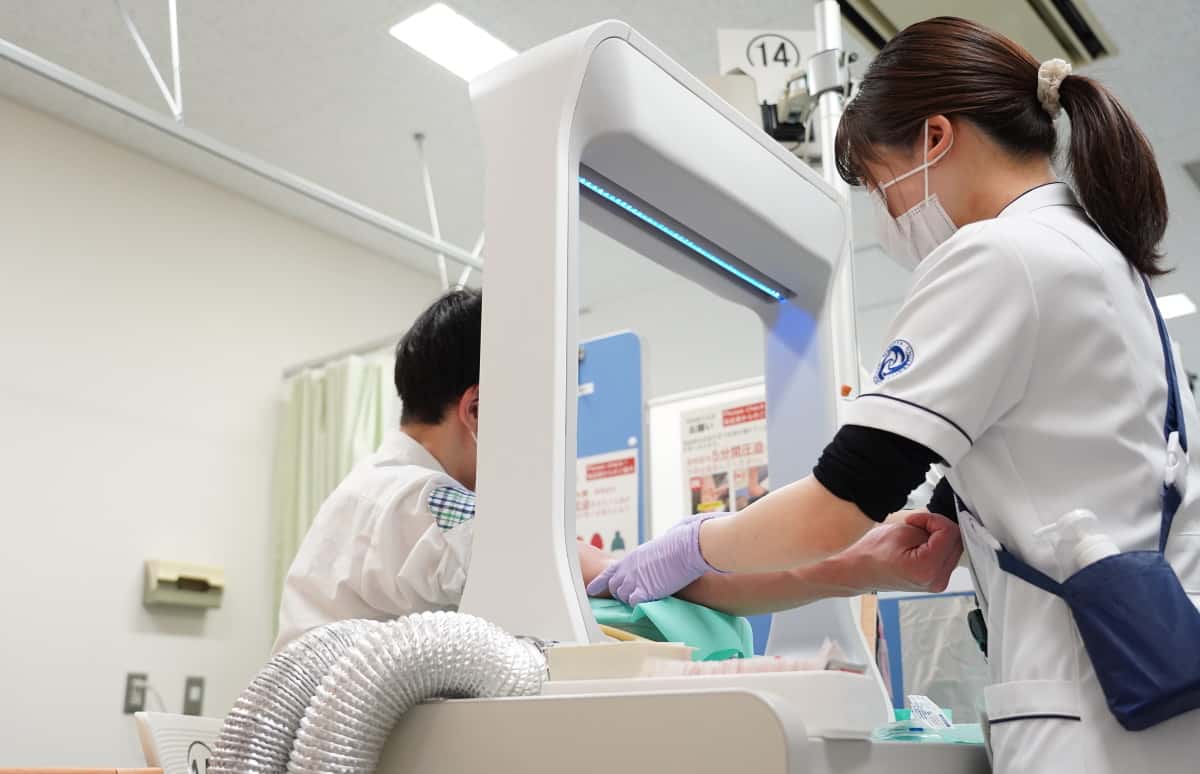
Medical procedures such as collection of blood samples or intubation, for example, require doctors and other healthcare staff to work in close proximity to the patient. To protect them from exposure to infections in such scenarios, a team at Nagoya University in Japan has developed a desktop air curtain system (DACS) that blocks emitted aerosol particles and prevents potential spread of viruses such as SARS-CoV-2.
The DACS contains a generator at the top that produces a steady airflow, which is then guided to a suction port at the bottom of the device, effectively creating a smooth curtain of air. As this integrated system contains both a discharge and a suction port, it can be installed at any location, and is portable enough to be placed on a desk. A high-efficiency particulate air (HEPA) filter inside the suction port can provide air purification.
“We envisage this system will be effective as an indirect barrier for use in blood-testing labs, hospital wards, and other situations where sufficient physical distance cannot be maintained, such as at a reception counter,” says first author Kotaro Takamure in a press statement.
To assess the potential of using the DACS in a medical environment, Takamure and colleagues performed a series of experiments using a set-up replicating a blood-collection booth. First, they used particle image velocimetry (PIV) and a hot-wire anemometer to evaluate the velocity field of the air curtain. The measurements confirmed that the flow rate of the air curtain generated by the DACS is maintained from the discharge port up to the suction port.
Next, the team used an air compressor connected to a mannequin to simulate human exhalation. A tube at the mouth of the mannequin blew out air containing aerosol particles (2–3 µm-diameter particles of the solvent dioctyl sebacate) towards the air curtain at a flow rate of 52 l/min. The distance from the air outlet to the centre of the DACS was 250 mm.
With the DACS switched off, PIV measurements showed that the emitted aerosol particles diffused as they moved forward and travelled straight through the gate of the DACS to the other side. The particles had maximum velocity immediately after ejection from the mannequin’s mouth and then gradually slowed.
When the DACS is operational, the researchers observed similar initial behaviour. However, when the aerosol particles approached the gate, they were bent abruptly downward along with the air curtain flow and were eventually sucked into the suction port, with none passing through the gate.
The researchers then investigated a scenario mimicking the use of the DACS during blood collection, with the arm of the mannequin resting on the gate. They saw that arm disrupted the curtain’s airflow, creating turbulent flow nearby. The aerosol blocking performance, however, was unaffected. Statistical evaluations revealed that even with the arm on the gate, no aerosol particles reached the other side of the air curtain, demonstrating effective particle blocking even in the presence of turbulence.
The team is now also integrating a virus inactivation system into the DACS, using UV LEDs connected to the suction port. The UV irradiation destroys the outer coat of virus particles; the sanitized air can then be recirculated to maintain airflow of the air curtain. Laboratory tests revealed that the combination of the air curtain with UV irradiation inactivated 99.9% of SARS-CoV-2 particles.

Far-UVC light zaps airborne pathogens in realistic conditions
“Although acrylic sheets are currently widely used as partitions, our air curtain not only blocks, but also deactivates, viruses,” says co-author Tomomi Uchiyama. “Therefore, we expect this device to render acrylic partitions obsolete and become widely used.”
Takamure says that the group’s future goal is to develop a compact and lightweight virus inactivation device. “If we can achieve miniaturization without compromising virus inactivation performance, we expect the device to be more versatile,” he tells Physics World.
The DACS is described in AIP Advances.
